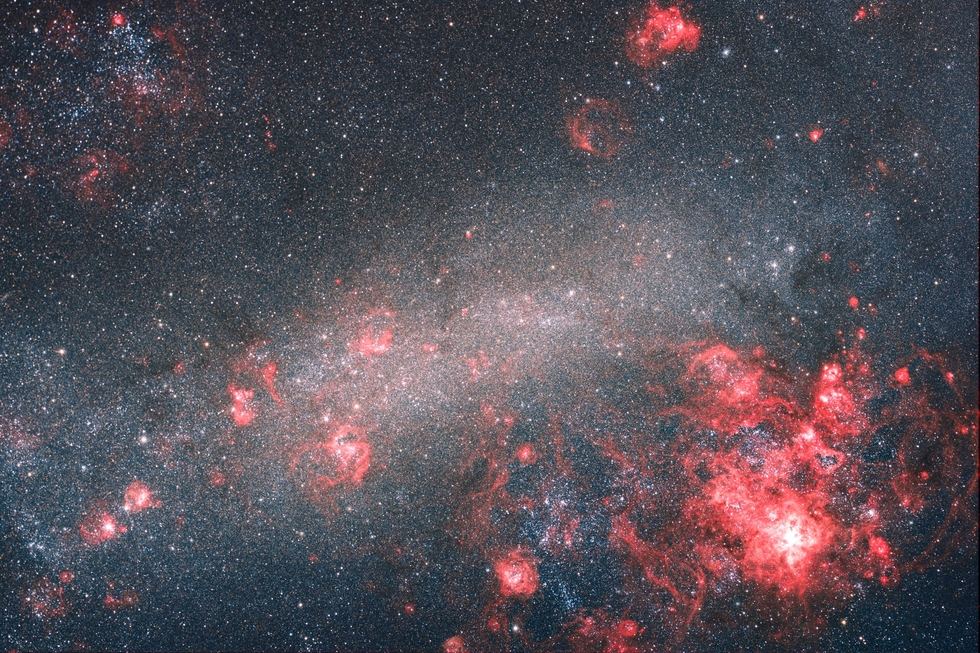Large Magellanic Cloud
Large Magellanic Cloud
The Large Magellanic Cloud Large Magellanic Cloud () is a dwarf galaxy, probably a satellite of the Milky Way, and the larger of the two Magellanic Clouds. Due to its relatively short distance of only 48 kpc (160,000 al), it is the closest galaxy to the Milky Way after the Canis Major (12.9 kpc (42,000 al)) and Sagittarius (16 kpc (52,000 al)), the latter located on the opposite side of the galactic center from the solar system.
The Large Magellanic Cloud has a mass equivalent to about 10 billion times that of the Sun (1010 solar masses), equal to about one-tenth the mass of the Milky Way, or about 20 billion stars; With a diameter of about 14 000 light-years, it is also the fourth largest galaxy in the Local Group, after Andromeda, the Milky Way and the Triangulum Galaxy.
Although the Large Cloud is often considered an irregular galaxy, it contains a thick bar running through its center that suggests that it was originally a barred spiral galaxy that, due to the large tidal forces due to interaction with our Galaxy and the Small Magellanic Cloud, has been deformed. NASA's database of extragalactic objects considers it to be SB(s) m, according to Hubble's classification.
It is visible to the naked eye as a faint object in the night sky of Earth's Southern Hemisphere, bordering the constellations Dorado and Mensa. It is named in honor of Ferdinand Magellan who observed it together with his companion (called the Little Magellanic Cloud) on his voyage of circumnavigation of the Earth.
In the cloud is the Tarantula Nebula, the most active star-forming region of the Local Group of galaxies. Also, in 1987, the explosion of what would become known as Supernova 1987a was observed in the Cloud.
The Large Magellanic Cloud has a mass equivalent to about 10 billion times that of the Sun (1010 solar masses), equal to about one-tenth the mass of the Milky Way, or about 20 billion stars; With a diameter of about 14 000 light-years, it is also the fourth largest galaxy in the Local Group, after Andromeda, the Milky Way and the Triangulum Galaxy.
Although the Large Cloud is often considered an irregular galaxy, it contains a thick bar running through its center that suggests that it was originally a barred spiral galaxy that, due to the large tidal forces due to interaction with our Galaxy and the Small Magellanic Cloud, has been deformed. NASA's database of extragalactic objects considers it to be SB(s) m, according to Hubble's classification.
It is visible to the naked eye as a faint object in the night sky of Earth's Southern Hemisphere, bordering the constellations Dorado and Mensa. It is named in honor of Ferdinand Magellan who observed it together with his companion (called the Little Magellanic Cloud) on his voyage of circumnavigation of the Earth.
In the cloud is the Tarantula Nebula, the most active star-forming region of the Local Group of galaxies. Also, in 1987, the explosion of what would become known as Supernova 1987a was observed in the Cloud.
SPECIFICATIONS
Telescope
AUS-2-CMOS
Camera
QHY 600M Pro
Location
HEAVEN'S MIRROR OBSERVATORY, AUSTRALIA
Date of observation
16-17 / 03-2023
Filters
HLRGB
Processing
Pixinsight and Photoshop
Credits
Credit Sauro Gaudenzi / Data Telescope Live


